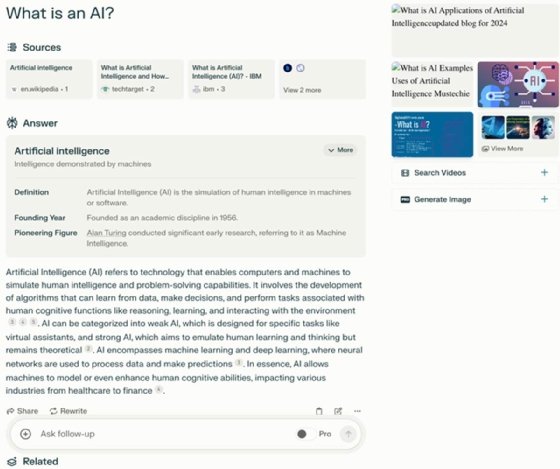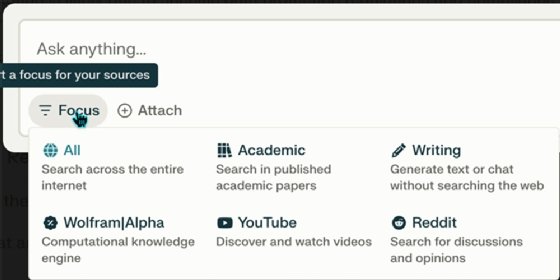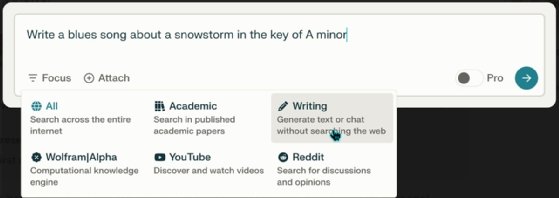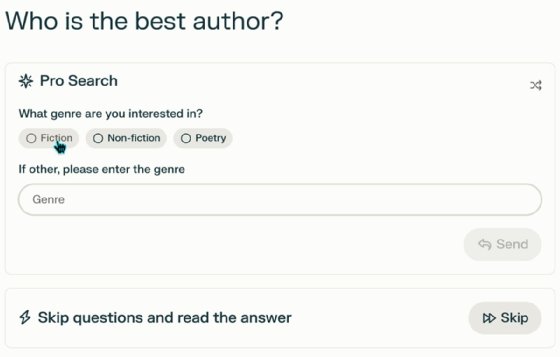How to use Perplexity AI: Tutorial, pros and cons
AI-powered search engine Perplexity offers a conversational tone and much-needed source citations -- but it's not perfect. Learn how the tool works and how to start using it.
AI is influencing many industries by improving how they gather, interpret and use data. For example, AI-powered search engines use algorithms that mimic aspects of human intelligence to help users find the information they need.
Many of today's AI tools use large language models (LLMs) for language generation. Using deep learning algorithms and massive data sets, these LLMs can consolidate information and generate new content. AI systems can integrate LLMs with other types of generative AI models to produce text, images, music and other types of data. The LLMs' capabilities dictate how the AI systems containing them respond to queries, making them a key component in the architecture for AI-powered search engines.
Perplexity AI distinguishes itself from other search engines by drawing on multiple LLMs to produce its responses. Unlike other search engine options, Perplexity provides information synthesized into an easily consumed natural language format with citations and detailed follow-ups.
Explore Perplexity AI's features, pros and cons, then follow the below tutorial to get started with the tool.
An overview of Perplexity AI
Perplexity is designed to help users search naturally for information. It takes a conversational approach, using natural language processing to interpret queries based on context. In addition, Perplexity offers follow-up suggestions for narrower searches to help users find exactly what they want.
This article is part of
What is GenAI? Generative AI explained
Perplexity is positioned as an alternative to traditional search engines like Google or DuckDuckGo; the company suggests users view it as a knowledgeable assistant helping you with your search. Unlike standard search engines, which offer users a list of links to follow themselves, Perplexity directly delivers information in response to users' queries.

Aside from search engine queries, Perplexity can also generate content, similar to AI chatbots like OpenAI's ChatGPT and Anthropic's Claude. Perplexity Pro lets users toggle between multiple LLMs made by other organizations, including image-generation models like Dall-E 3 and Stable Diffusion XL, which give the model multimodal capabilities. Among other generative abilities, Perplexity can produce written text, images and simple code.
Perplexity AI features and costs
Perplexity takes a conversational approach when responding to queries and can recognize and work with context. Users can also access multiple LLMs from different vendors with Perplexity, setting the tool apart from competitors like ChatGPT and Claude that primarily rely on their own LLM products. Perplexity is available worldwide with the exception of the EU, where regulatory restrictions and data protection laws limit its availability.
Perplexity offers three subscription formats:
- Standard, which is free.
- Pro, which costs $20 per month or $200 per year.
- Enterprise Pro, which offers flexible pricing based on team size.
Perplexity's free version doesn't require an account and supports unlimited basic searches, including citations and follow-up queries. It's simple to use: Just enter your question and start engaging with the results. This version uses OpenAI's GPT-3.5 model and lets users upload images, text and PDF files for use, though it limits uploads to three per day. And although the free version doesn't require an account, making one can be useful, thanks to benefits such as profile customization.
Perplexity Pro integrates more AI models and asks detailed clarifying questions. It also lets users upload unlimited PDFs, CSV files, images, text documents and more for analysis. The Pro version also lets users switch among LLMs to refine search results. The added selection of AI models -- including OpenAI's GPT-4 Omni, Anthropic's Claude 3.5 Sonnet and Sonar Large -- gives users more options for discovering information and for capitalizing on multimodal capabilities, such as image generation.
Perplexity Pro offers unlimited basic searches and 300-plus Pro Searches per day. The tier also offers API access for developers and $5 per month in API credits.
Building on the capabilities of Perplexity Pro, Perplexity Enterprise Pro comes with added administrator features like user management, single sign-on integration, enhanced security warnings, data retention and more.
How to use Perplexity AI
To get started with Perplexity AI, follow these steps.
1. Create a free Perplexity account
Although you can use Perplexity effectively without an account, creating one is useful. The ability to share collections, customization and enhanced preferences are beneficial features.
Create a free Perplexity account using your email, then set account preferences and a profile. The process is simple, though it does advertise the paid Perplexity Pro version.
Use the download link in the lower-left corner to add Perplexity to your iPhone or Android device or to integrate it with your browser.
2. Develop search queries
To get started, begin in the upper-left corner of Perplexity. Here, you'll find an option for a new query thread, along with the Home, Discover, Spaces and Library tabs.
Discover takes you to AI- and technology-oriented news headlines. The Library consists of recent query searches, and Spaces enables you to build collections to create, manage and organize your queries.
Use the Focus feature for more direct searches by choosing the category that most aligns with your query topic. The Focus feature makes Perplexity much more useful, considering the vast amount of information available online.

3. Test Perplexity's writing mode
Aside from responding to search queries, Perplexity AI offers generative language capabilities. To exercise the tool's creativity, I asked it to write me a song.

Here's the result.

While the rhyming is decent, notice that it took my request literally regarding a snowstorm in the key of A minor -- wherever that might be.
Using Perplexity Pro
Perplexity Pro takes the knowledgeable assistant concept a step further by asking users to clarify their requests when needed. Clear and basic questions probably won't require this feature, but open-ended and technical queries can benefit from follow-up questions.
In Figure 5, Perplexity responds to my vague query by asking a clarifying question regarding genre.

What do I think of Perplexity?
I'll admit it: I've been in technology for a long time, and I'm skeptical of ... well, pretty much everything, including AI. However, integrating Perplexity into my daily writing routine has made a real difference by saving me time and effort. I'm especially happy with the citations because they enable me to double-check information or delve deeper as needed. I also appreciate the natural language responses and have not run into query or token limitation problems yet.
Perplexity AI pros and cons
The advantages of Perplexity AI include the following:
- Easy to use.
- Powerful free version.
- Conversational style, with natural language queries and responses.
- Source citations, unlike many other generative AI tools.
- Flexibility, thanks to multiple LLM options.
- Ability to create collections to store and organize queries.
The disadvantages of Perplexity AI include the following:
- AI tools still return questionable information.
- Some responses are repetitive.
- Perplexity is vulnerable to any hallucinations or other issues affecting the third-party LLMs it accesses.
I'm still learning how to get the most out of Perplexity. I suggest you begin by creating a free account and using Perplexity to replace your standard search engine queries. After a few days, review the comprehensive FAQs to learn more tips and tricks, and take a look at the technical FAQs if you're a developer or advanced user. It can also be helpful to download the smartphone version and integrate it into your activities.
Editor's note: This tutorial was originally written in 2024. Informa TechTarget Editorial updated it in 2025 with relevant product information to improve readability.
Damon Garn owns Cogspinner Coaction and provides freelance IT writing and editing services. He has written multiple CompTIA study guides, including the Linux+, Cloud Essentials+ and Server+ guides, and he contributes extensively to Informa TechTarget Editorial and the CompTIA Blog.








